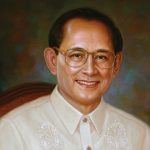Nacionalista Party leader Ferdinand Marcos dominated the political scene of the Philippines for two decades after his election to the presidency in 1965. During his first term, Marcos initiated ambitious public works projects that improved the general quality of life while providing generous pork-barrel benefits to his friends. Marcos perceived that his promised land reform program would alienate the politically all-powerful landowner elite, and thus it was never forcefully implemented. He lobbied strenuously for economic and military aid from the United States while resisting significant involvement in the Second Indochina War (1954–75).
In 1967 the Philippines became a founding member of the Association of Southeast Asian Nations (ASEAN). Marcos became the first president to be reelected (in 1969), but early in his second term economic growth slowed, optimism faded, and the crime rate increased. In addition, a new communist insurgency, this time—starting in 1968—led by the new Communist Party of the Philippines-Marxist-Leninist and its military arm, the New People’s Army, was on the rise. In 1969 the Moro National Liberation Front was founded and conducted an insurgency in Muslim areas. Political violence blamed on leftists, but probably initiated by government agents provocateurs, led Marcos to suspend habeas corpus as a prelude to martial law.
Marcos declared martial law on September 21, 1972, and did not lift it until January 17, 1981. During this time, he called for self-sacrifice and an end to the old society. However, in the “New Society” Marcos’s cronies and his wife, former movie actress Imelda Romualdez-Marcos, wilfully engaged in rampant corruption. With her husband’s support, Imelda Marcos built her own power base. She became governor of Metropolitan Manila and minister of human settlements. The previously nonpolitical armed forces became highly politicized, with high-ranking positions being given to Marcos loyalists. In 1979 the United States reaffirmed Philippine sovereignty over U.S. military bases and continued to provide military and economic aid to the Marcos regime. When martial law was lifted in 1981 and a “New Republic” proclaimed, little had actually changed, and Marcos easily won reelection.
The beginning of the end of the Marcos era occurred when his chief political rival, Liberal Party leader Benigno “Ninoy” Aquino, who had been jailed by Marcos for eight years, was assassinated as he disembarked from an airplane at the Manila International Airport on August 21, 1983, following medical treatment in the United States. Marcos cronies were charged with this crime but were acquitted. Aquino, however, became a martyr and his murder the focus of popular indignation against a corrupt regime.
The Catholic Church, a coalition of old political opposition groups, the business elite, the left wing, and even factions of the armed forces all began to exert pressure on the regime. There also was foreign pressure and, feeling confident with the support given by the Reagan White House, Marcos called a “snap” presidential election for February 7, 1986.
When the Marcos-dominated National Assembly proclaimed Marcos the winner, Cardinal Jaime Sin and key military leaders (including Minister of Defense Juan Ponce Enrile and acting Chief of Staff of the Armed Forces Lieutenant General Fidel V. Ramos) rallied around the apparent majority vote winner, Aquino’s widow, Corazon Cojuango Aquino. The People Power Movement—a popular uprising of priests, nuns, ordinary citizens, and children, supported by defecting military units—ousted Marcos on the day of his inauguration (February 25, 1986) and brought Aquino to power in an almost bloodless revolution.




